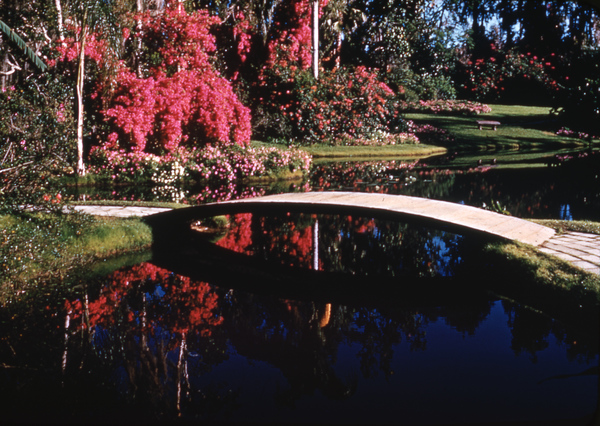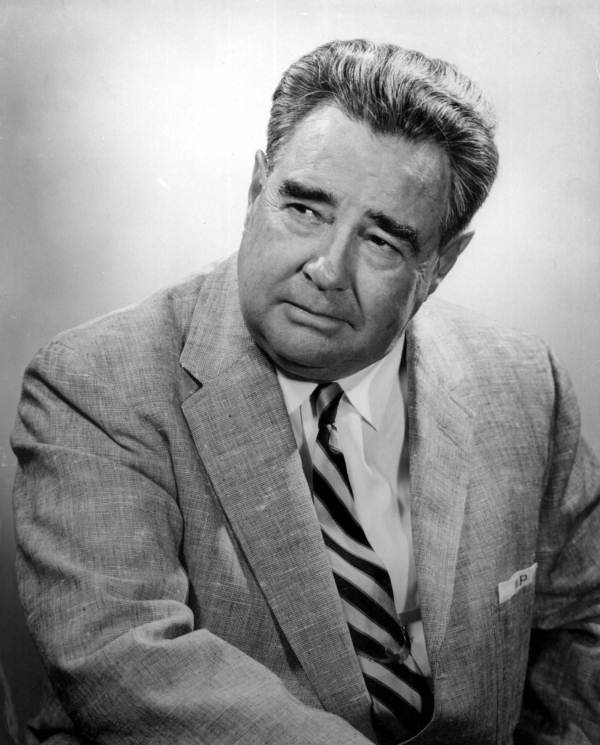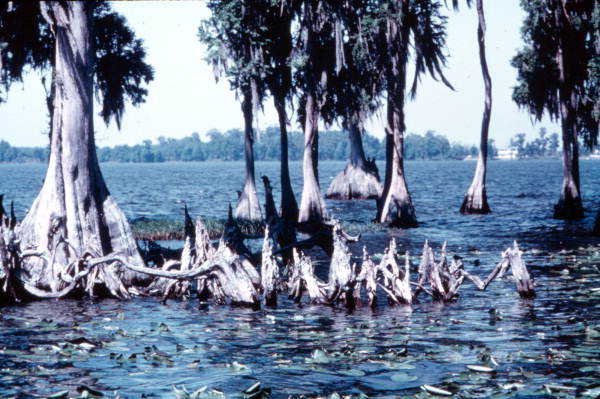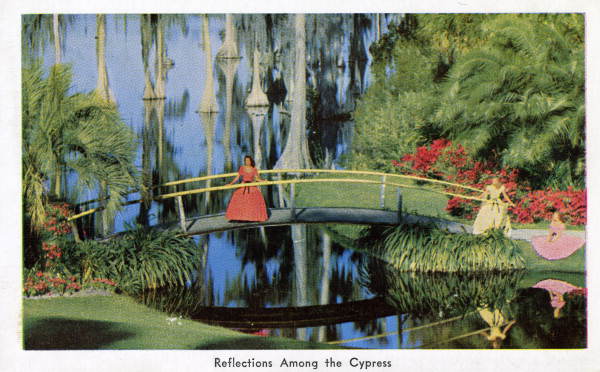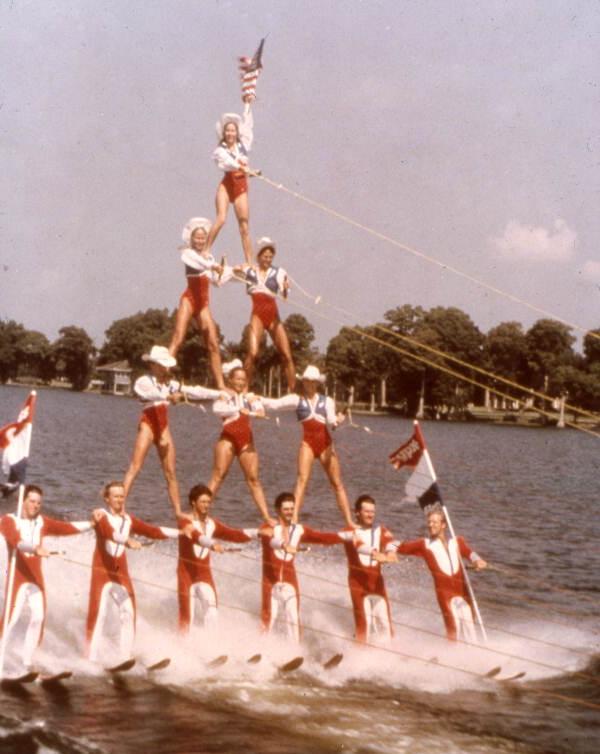Description of previous item
Description of next item
The "Swami of the Swamp": Dick Pope and Florida's Cypress Gardens
Published June 6, 2014 by Florida Memory
Cypress Gardens, one of Florida’s earliest and most famous themed attractions, has been capturing the imaginations of visitors for over seventy years. Originally opened by visionary promoter Dick Pope and his wife Julie in the mid-1930s, the gardens featured acres of blooming flowers, trees, and shrubbery, along with aquatic stunt shows and boat tours.
Although the beauty of the gardens alone makes them a Florida treasure, the story of how Cypress Gardens came to be is an equally valuable part of the rich history of Florida tourism. The land was little more than a swamp when founder Dick Pope acquired it, but Pope’s cunning business mind combined with a little luck to make the whole production come off beautifully. As Pope once told author Norman Vincent Peale, his motto was to “think big about everything.”
The idea to build a botanical garden for tourists came to Pope during a rough patch in his life. In the 1910s and 1920s, he and his brother Malcolm had been heavily involved in aquatic stunts and boat racing, as well as developing promotions for outboard motor companies like Johnson Motors. As the Great Depression took hold, however, demand for his services dropped, and Pope found himself looking for other projects. He was riding with his wife Julie in their car one day when a magazine article caught his eye. A man in Charleston, South Carolina had built up an impressive set of gardens on his estate, and had had success getting tourists to pay a small admission charge to visit. Dick Pope decided he could do something similar in Winter Haven, Florida, where he had spent much of his childhood and teenage years.
Pope quickly bought up several acres of land and a shuttered boat club on Lake Eloise and began preparing them for service as a botanical garden. The labor necessary to achieve this was extensive, of course, but Pope had a few ideas up his sleeve. He approached the local commission charged with managing the canals connecting Lake Eloise with the neighboring bodies of water, and convinced its board to invest $2,800 in his project, which he called “a community park.” He also incorporated the new attraction as a non-profit organization so he could apply for funding from the Works Progress Administration to construct it. After touring the area in a boat with Dick Pope explaining his plans, representatives from the WPA signed off on the project, and soon Dick Pope had a group of federal relief workers busy clearing brush, improving canals, and laying out walkways to serve the new gardens.
It wasn’t long before local and federal officials realized that this was much more a private venture than a community park, and the WPA and the local canal commission withdrew their support. Pope was jokingly labeled the “Swami of the Swamp” and the “Maharaja of Muck” for his manipulative handiwork, but he remained determined to open Cypress Gardens. He reorganized the business and began the planting process with the help of gardener Vernon Rutter of Tennessee. Julie Pope was heavily involved as well, as her husband admitted that he “didn’t know an azalea from a carrot” in those early days. Pope also enlisted the assistance of photographer Robert Dahlgren to ensure that the gardens were laid out in such a way that no matter which direction a camera was pointed, the photograph it captured would be appealing.
Cypress Gardens officially opened on January 24, 1935. Pope pulled every string in his arsenal of connections to get photographs of the gardens placed in newspapers and magazines across the country. He even managed to get the new attraction featured in several films, which added to the publicity. He invited beauty queens, movie stars, aquatic stunt performers – anyone who might draw attention to Cypress Gardens. Over time, the gardens would host a wide array of distinguished guests, including Bette Davis, Joan Crawford, President John F. Kennedy, and King Hussein of Jordan. Even the Shah of Iran came once to water-ski on the lake. Asked about the honor of hosting the Shah, Pope quipped, “There’s no business like Shah business.”
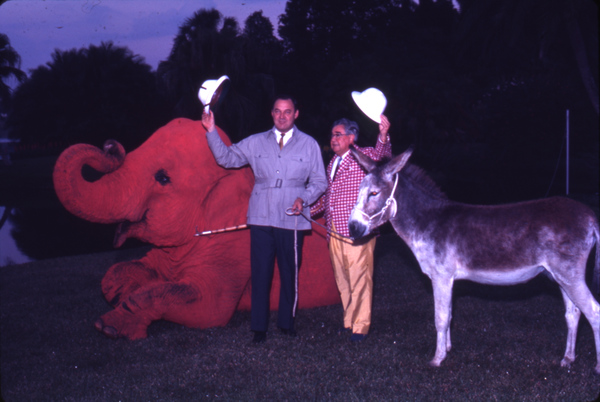
Dick Pope (right) with Governor Claude Kirk (left) at Cypress Gardens. Pope served on a number of commissions to promote Florida tourism during his career (photo 1967).
Cypress Gardens remained successful in the coming years, although changes in tourism and demographics began taking their toll by the early 1970s. Gas prices and shortages, the arrival of larger parks like Walt Disney World, and the tendency of families to make shorter, more location-specific trips cut into the attraction’s market share. Dick Pope and his son, Dick Pope, Jr., tried to adjust to meet the challenge, but found it impossible to catch up. The attraction changed hands several times before finally closing in 2009. The gardens themselves have been preserved as part of a new attraction called Legoland.
Dick Pope passed away in 1988, but his contributions to Florida tourism are honored in several lasting tributes. The University of Central Florida’s Institute for Tourism Studies is named for him, and in 2014 Cypress Gardens was added to the National Register of Historic Places.
Search the Florida Photographic Collection to find more photos of your favorite Florida tourist attractions.
Cite This Article
Chicago Manual of Style
(17th Edition)Florida Memory. "The "Swami of the Swamp": Dick Pope and Florida's Cypress Gardens." Floridiana, 2014. https://www.floridamemory.com/items/show/295183.
MLA
(9th Edition)Florida Memory. "The "Swami of the Swamp": Dick Pope and Florida's Cypress Gardens." Floridiana, 2014, https://www.floridamemory.com/items/show/295183. Accessed December 30, 2025.
APA
(7th Edition)Florida Memory. (2014, June 6). The "Swami of the Swamp": Dick Pope and Florida's Cypress Gardens. Floridiana. Retrieved from https://www.floridamemory.com/items/show/295183

 Listen: The World Program
Listen: The World Program